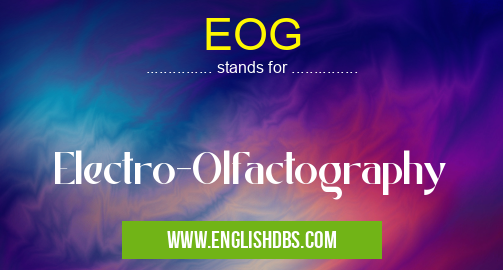What does EOG mean in ACADEMIC & SCIENCE
Electro-Olfactography (EOG) is a valuable scientific technique used to measure the electrical responses of the olfactory system, particularly the olfactory epithelium, to various odorants. It provides insights into the mechanisms underlying odor detection, discrimination, and recognition.

EOG meaning in Academic & Science in Academic & Science
EOG mostly used in an acronym Academic & Science in Category Academic & Science that means Electro-Olfactography
Shorthand: EOG,
Full Form: Electro-Olfactography
For more information of "Electro-Olfactography", see the section below.
Principle of EOG
EOG involves placing electrodes on the olfactory epithelium, which is located in the nasal cavity. When an odorant is introduced, it interacts with odorant receptors in the olfactory epithelium, triggering electrical signals. These electrical responses are recorded by the electrodes and amplified for analysis.
Applications of EOG
1. Olfactory Function Assessment: EOG can evaluate the functionality of the olfactory system, diagnose olfactory disorders, and monitor therapeutic interventions.
2. Odor Discrimination and Identification: EOG helps researchers understand how the olfactory system distinguishes between different odors and identifies specific odorants.
3. Odorant Receptor Characterization: By studying the electrical responses to specific odorants, scientists can characterize and classify odorant receptors, providing insights into their selectivity and specificity.
4. Environmental Monitoring: EOG can be used to detect and identify odors in various environments, such as air quality monitoring, industrial settings, and food safety.
Advantages of EOG
- Non-invasive technique
- High sensitivity and specificity
- Can provide real-time measurements
- Allows for the study of olfactory responses to complex odor mixtures
Limitations of EOG
- Can only measure electrical responses from the olfactory epithelium
- Requires specialized equipment and expertise
- May not always reflect the subjective perception of odors
Essential Questions and Answers on Electro-Olfactography in "SCIENCE»SCIENCE"
What is Electro-Olfactography (EOG)?
Electro-Olfactography (EOG) is a technique used to measure the electrical activity of the olfactory epithelium, which is the sensory tissue responsible for detecting odors. It provides insights into the physiological mechanisms of olfaction and can be used to study olfactory disorders.
How does EOG work?
EOG is based on the principle that when odor molecules bind to receptors in the olfactory epithelium, it generates an electrical potential difference across the epithelium. This potential difference can be recorded using electrodes placed on the surface of the epithelium. The resulting electrical signal provides information about the odor stimulus and the response of the olfactory system.
What applications does EOG have?
EOG has several applications, including:
- Diagnosis of olfactory disorders, such as anosmia (loss of smell) and hyposmia (reduced sense of smell).
- Studying the physiology of olfaction, including odor discrimination, adaptation, and receptor selectivity.
- Developing new odor-based diagnostic tools and therapies.
What are the limitations of EOG?
EOG has some limitations, such as:
- It only measures the electrical activity of the olfactory epithelium, not the activity of other parts of the olfactory system.
- It can be difficult to record stable and reliable signals in some individuals.
- The interpretation of EOG signals can be complex and may require specialized expertise.
How can EOG be used to diagnose olfactory disorders?
In the diagnosis of olfactory disorders, EOG can help:
- Confirm the presence of an olfactory deficit.
- Differentiate between different types of olfactory disorders, such as anosmia and hyposmia.
- Monitor the progress of olfactory function over time.
Final Words: Electro-Olfactography is a powerful tool for studying the olfactory system. It has applications in clinical diagnosis, odorant research, and environmental monitoring. By understanding the electrical responses of the olfactory epithelium, EOG contributes to our knowledge of odor perception and the neural mechanisms underlying olfaction.
EOG also stands for: |
|
| All stands for EOG |
